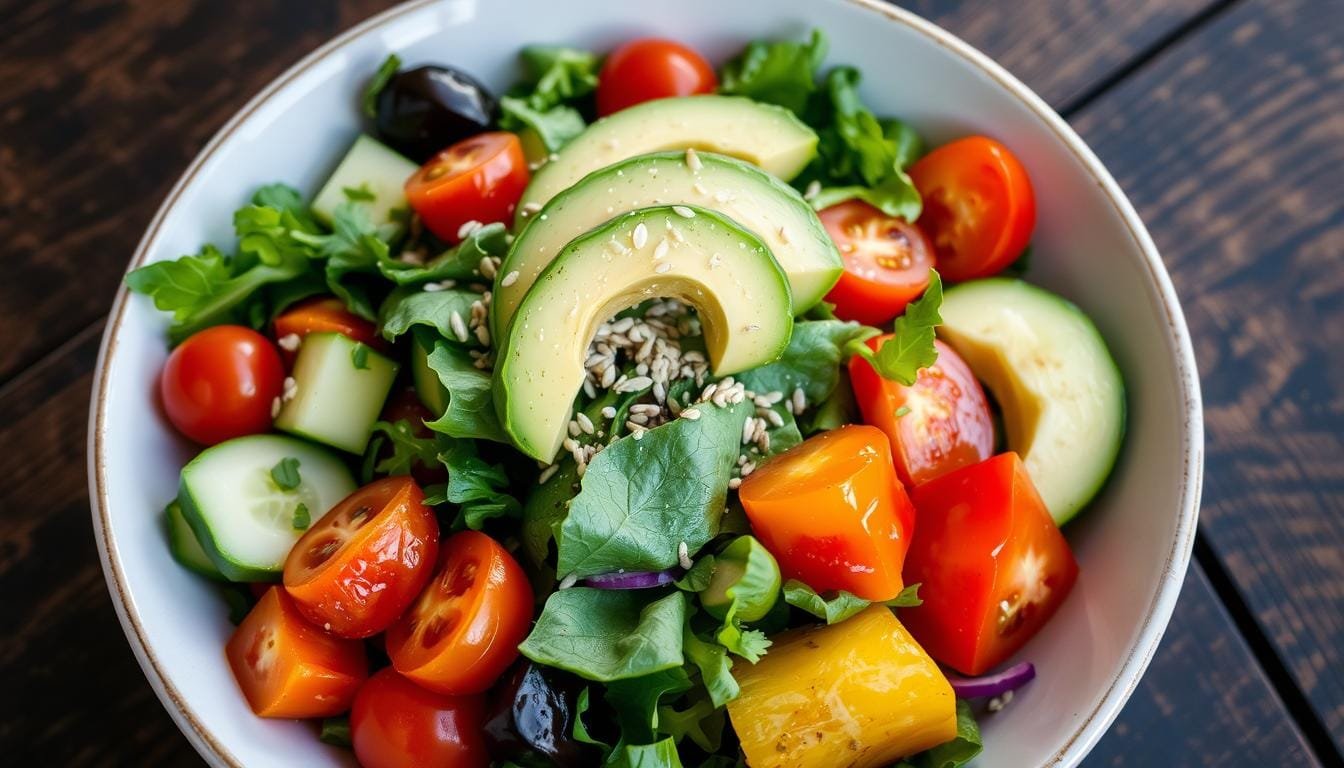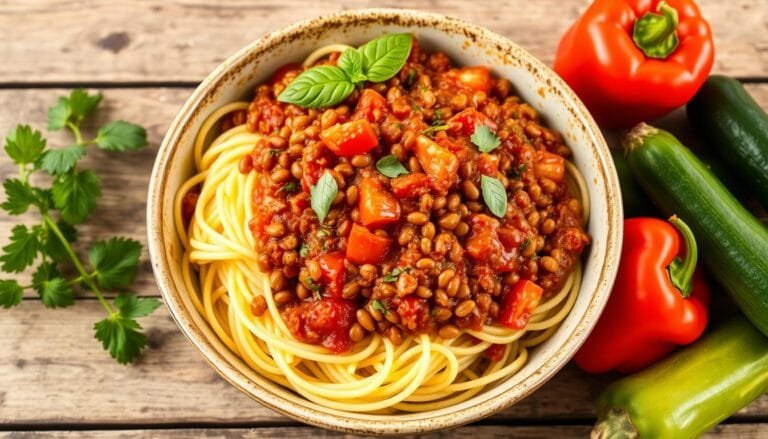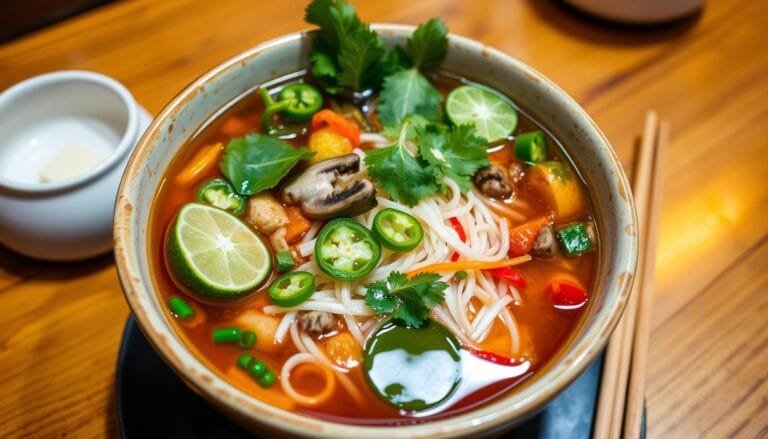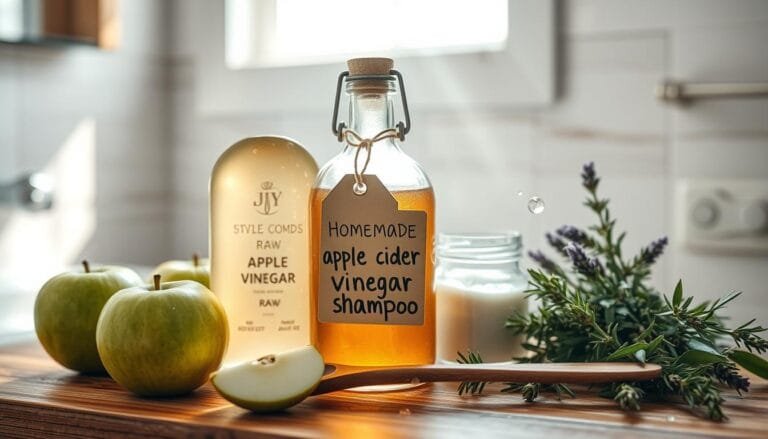I’m excited to share a collection of fresh and healthy vegan salad recipes with you. These salads show how versatile plant-based cooking can be. They range from crisp garden-fresh creations to hearty grain-based bowls full of protein and flavor.
Looking for a light lunch, a side dish, or a wholesome dinner? This guide has you covered. It caters to different dietary preferences and nutritional needs.
The amazing vegan salad recipes I’ve curated use a variety of fresh, nutrient-rich ingredients. They will excite your taste buds and nourish your body. From the Spicy Korean Cucumber Salad to the Roasted Butternut Squash Kale Salad, and the Vegan Cobb Salad to the Japanese Sesame Spinach Salad, each recipe offers a unique flavor and a lot of plant-based goodness.
Exploring these recipes will show you the benefits of plant-based eating. It can improve your health and well-being. These salads are not only tasty but also packed with vitamins, minerals, and antioxidants. They support your body’s needs.
Understanding the Power of Plant-Based Salads
Choosing a plant-based lifestyle brings many benefits. It helps keep your immune system strong and boosts overall health. In fact, 70% of the immune system resides in the gut. Adding more plant-based salads to your diet can nourish your body and unlock the power of plant-based nutrition.
Benefits of Plant-Based Eating
Eating a balanced diet rich in fruits, vegetables, whole grains, and vegan protein sources is key. It gives you essential vitamins, minerals, and antioxidants. These nutrients are vital for a strong immune system, healthy digestion, and lower disease risk.
Key Nutrients in Plant-Based Salads
Plant-based salads are full of important nutrients. They often have protein from tofu, chickpeas, beans, and lentils. This protein keeps you full and satisfied. Salads also have fiber, healthy fats from nuts and seeds, and many vitamins and minerals for a balanced vegan diet.
Building a Balanced Vegan Salad
Making a nutritious vegan salad is an art. Mix colorful vegetables, protein-rich plant-based ingredients, and tasty dressings for a complete meal. By combining different textures and flavors, you get a salad that looks good and is full of nutrients to fuel your body and mind.
“A plant-based diet rich in fruits, vegetables, and whole grains can provide an abundance of essential vitamins, minerals, and antioxidants that support overall health and well-being.”
| Nutrient | Amount per Serving |
|---|---|
| Calories | 513 |
| Carbohydrates | 65g |
| Protein | 16g |
| Fat | 25g |
| Fiber | 18g |
| Sodium | 354mg |
| Vitamin A | 8454IU |
| Vitamin C | 60mg |
By embracing plant-based salads, you nourish your body, support your immune system, and enjoy a delicious meal. It’s a choice that aligns with a healthy lifestyle.
Essential Plant-Based Protein Sources for Salads
Making tasty and healthy plant-based salads is easy with many protein-rich foods. You can use tofu, chickpeas, and beans for a classic taste. Also, lentils, nuts, and seeds are packed with nutrients to add protein to your salads.
For those who avoid dairy, vegan yogurt and cheese are great protein sources. They add a creamy, satisfying element to your salads. Whole grains like quinoa, barley, and millet also offer protein and a hearty texture.
Looking for a protein-rich salad for lunch or dinner? These vegan protein options will make your salads more filling and energizing. Try mixing different ingredients to find your new favorite salad.
| Protein Source | Protein Content |
|---|---|
| Tofu (1/2 cup, cubed) | 10g |
| Chickpeas (1 cup) | 15g |
| Lentils (1 cup, cooked) | 18g |
| Almonds (1/4 cup) | 6g |
| Quinoa (1 cup, cooked) | 8g |
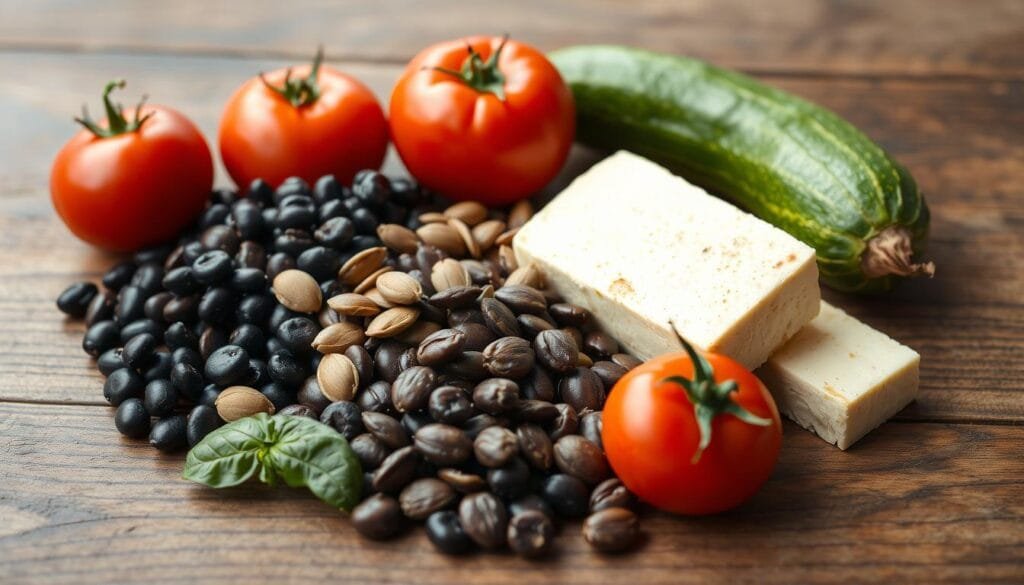
“Adding a variety of vegan protein sources to your salads boosts nutrition. It also enhances texture and flavor, making them more satisfying and filling.”
Healthy Plant-Based Salad Recipes for Every Season
Enjoy the fresh produce of each season with these healthy plant-based salad recipes. They range from bright spring salads to warm winter dishes. These recipes show how versatile seasonal ingredients can be and the benefits of eating plants.
Spring Favorites
Welcome spring with a green bean salad in creamy mustard dressing or a tahini-dressed salad with colorful veggies. These salads are great for outdoor meals or as a side to your main dish.
Summer Delights
Beat the heat with pasta salads full of fresh herbs, juicy fruits, and tangy vinaigrettes. These salads are not just tasty but also packed with protein, making them a fulfilling meal or side.
Fall Harvest Options
Enjoy the harvest season with roasted sweet potato salads or kale-based creations. These salads highlight autumn’s rich flavors and offer a filling plant-based meal.
Winter Warmers
Cozy up with grain-based salads loaded with roasted root veggies and winter greens. These winter vegan meals provide warmth, texture, and bold flavors to keep you going all season.
“Eating seasonally is not just about enjoying the freshest produce, but also about embracing the natural rhythms of the earth and its bountiful gifts.”
Whether you’re in the mood for a light spring salad or a warm winter dish, these plant-based recipes have you covered. Enjoy the flavors of each season!
Mediterranean-Inspired Vegan Salad Creations
These vegan salads bring the Mediterranean’s vibrant flavors to life. They’re perfect for those who love plant-based food. From the crunchy fattoush salad to the hearty couscous with roasted veggies, they show off Mediterranean ingredients.
The Vegan Mediterranean Cucumber Chickpea Salad is a standout. It’s a mix of crisp cucumbers, chickpeas, tangy olives, and creamy avocado. Tossed in a tahini-lemon dressing, it’s enhanced by za’atar spice and pine nuts.
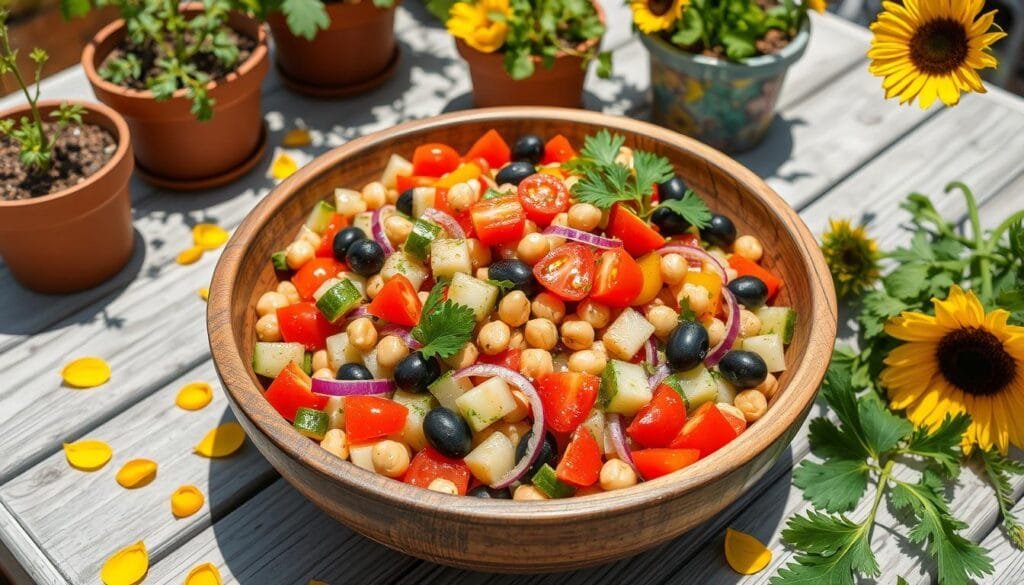
The Vegan Chickpea Salad is another favorite. It has fresh herbs, juicy tomatoes, crisp cabbage, and chickpeas. The dressing, with red wine vinegar and olive oil, brings everything together. It’s not just tasty but also packed with protein.
The Couscous with Roasted Vegetables salad is great for a filling meal. It has fluffy couscous with roasted zucchini, bell peppers, and onions. The dressing, with creamy tahini, adds to the flavor.
These salads are not just good-looking but also full of nutrients. They’re made with fresh produce, healthy fats, and plant-based proteins. Enjoy them as a main dish or side, and let the Mediterranean’s flavors take you on a culinary journey.
Asian-Fusion Plant-Based Salad Combinations
Get ready for a flavor journey with our Asian-fusion plant-based salads! These dishes mix Asian traditions with fresh, healthy ingredients. You’ll find everything from Thai noodle salads to Japanese spinach and Korean cucumber bites.
Thai-Inspired Options
Experience Thailand’s bold flavors with our Thai-inspired salads. They feature peanut sauce, crunchy veggies, and fresh herbs. Each bite is a mix of sweet, sour, and spicy, making them unforgettable.
Japanese-Style Selections
Discover Japanese plant-based salads’ simple yet refined charm. They often include sesame-dressed spinach, creamy avocado, and unique flavors. Enjoy the mix of textures and the subtle, umami taste that’s key to Japanese cuisine.
Korean-Influenced Recipes
Try our Korean-inspired salads for a burst of tangy flavors. They use gochugaru and gochujang spices, with crisp cucumbers and carrots. These salads are a true taste of Korean vegan cuisine.
Start your Asian-fusion salad adventure today! Explore the wide range of flavors and textures. Your plant-based meals will never be the same.
Grain-Based Power Salads
Grain-based power salads are great for a filling, healthy meal. They mix whole grains, veggies, and legumes with tasty dressings. Whole grain salads, quinoa recipes, farro salads, and bulgur wheat dishes make for satisfying meals.
For a grain salad bowl, start with 2 big handfuls of greens. Add 1/2 cup of cooked whole grains and 1/2 cup of beans or legumes. Use greens like mixed greens, spinach, arugula, and kale. Choose whole grains like brown rice, quinoa, or barley. Beans and lentils are great for protein.
To add flavor and texture, include lots of chopped veggies. Try cucumbers, tomatoes, carrots, and mushrooms. Healthy fats like cheese, nuts, or avocado make the salads even better.
The article shares many grain salad bowl ideas. Try Quinoa Chickpea Salad, Kale and brown rice with edamame, or Spinach with barley and lentils. The Fall Harvest Salad with Watermelon, Butternut Squash, and Farro is a tasty, seasonal option.
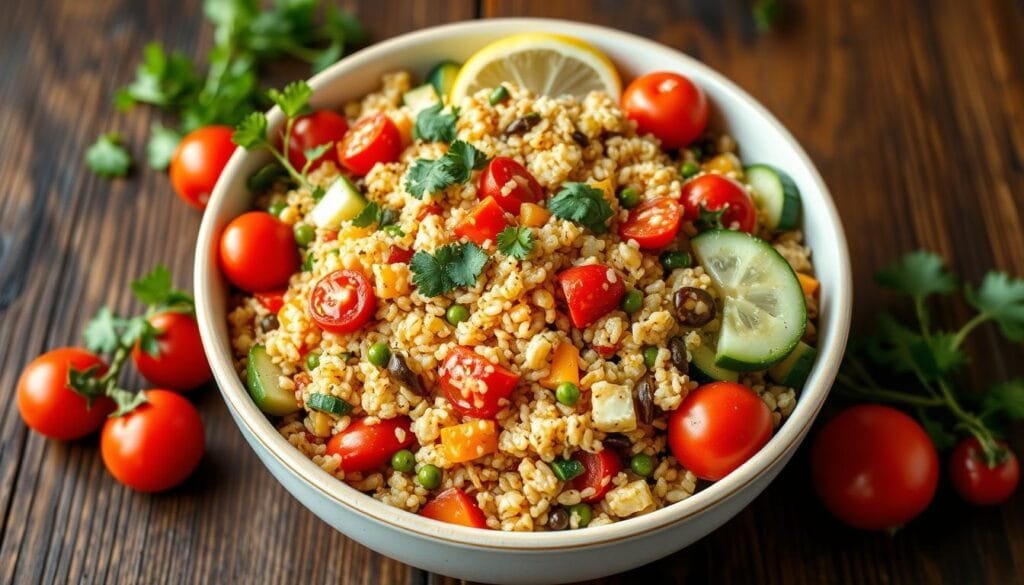
These grain-based power salads are packed with nutrients and taste great. They’re perfect for meal prep or a quick lunch. They’ll be a favorite in your plant-based cooking.
Creative Dressings and Vinaigrettes for Plant-Based Salads
Take your plant-based salads to the next level with the right dressing. Ditch the unhealthy oils and preservatives found in store-bought options. Instead, try making your own vegan salad dressings. They will make your greens truly special.
Oil-Free Options
Looking for something lighter? Try oil-free dressings. A tahini-based dressing is rich and pairs well with greens. Fruit-based vinaigrettes, like lemon-tahini or strawberry, are refreshing and light.
Creamy Nut-Based Dressings
Want something creamy? Nut-based dressings are the answer. Made with cashews or almonds, they’re rich but guilt-free. Try a creamy ranch or tofu-based dressing with fresh herbs for a gourmet salad.
Citrus-Based Vinaigrettes
For a burst of flavor, citrus vinaigrettes are perfect. Mix a tangy balsamic or zesty peanut butter and wasabi dressing. They’re great with greens and crunchy veggies.
With 16 vegan salad dressing recipes, you can create endless salad perfection. From oil-free to creamy nut-based and citrusy vinaigrettes, there’s something for everyone. Elevate your salads with these tasty, healthy dressings.
| Dressing Recipe | Prep Time | Nutrition (per 3 tbsp serving) |
|---|---|---|
| Lemon-Tahini Dressing | 10 minutes | 28 calories, 2g carbs, 2g protein, 1g fat |
| Creamy Cashew Ranch | 15 minutes | 67 calories, 13g carbs, 1g protein, 1g fat |
| Strawberry Vinaigrette | 12 minutes | 42 calories, 10g carbs, 1g protein, 1g fat |
| Peanut Butter Wasabi Dressing | 8 minutes | 34 calories, 2g carbs, 2g protein, 2g fat |
With these vegan salad dressing recipes, you’ll have endless flavors to enhance your salads. Enjoy the perfect mix of vegan, oil-free, nut-based, and citrus dressings. Your taste buds will thank you.

Make-Ahead Salad Prep Tips and Storage
Meal prepping plant-based salads can change your life for the better. It makes eating healthy and easy. Here are some top tips for keeping your salads fresh and tasty all week.
- Proper Layering: Start with hard items like cucumbers and carrots at the bottom. Then add leafy greens, and finish with soft ingredients like avocado.
- Airtight Containers: Use good, airtight containers to keep your salads fresh. This stops them from getting soggy or wilted.
- Separate Dressings: Store your salad dressings or vinaigrettes apart from the salad. This keeps the greens crisp.
- Refrigeration: Most salads stay good in the fridge for 3-4 days. Some items like berries and avocado don’t last as long. Check each ingredient’s shelf life for the best taste.
| Ingredient | Storage Duration |
|---|---|
| Leafy Greens | 3-4 days |
| Vegetables (Cucumbers, Carrots, Peppers) | 4-5 days |
| Proteins (Chickpeas, Tofu, Nuts) | 4-5 days |
| Fruits (Berries, Peaches) | 2-3 days |
| Avocado | 2-3 days |
Follow these meal prep tips and storage advice. You’ll enjoy fresh, healthy plant-based salads all week. It makes eating well easy and natural.
Seasonal Ingredients Guide for Fresh Salads
Making tasty plant-based salads means using seasonal produce. This way, every bite is full of flavor and nutrients. Let’s learn how to pick the best seasonal produce for amazing salads.
Shopping Tips
When you’re shopping for salad ingredients, remember a few things. Always choose seasonal produce that’s grown locally. Visiting farmers markets is a great way to find unique, organic vegetables. It also helps you support local farmers.
Take the time to talk to your local farmers. They can tell you about their growing methods. This ensures you get the freshest ingredients for your salads.
Produce Selection Guide
When picking salad ingredients, look at their ripeness, color, and appearance. Leafy greens should be crisp and bright. Fruits and veggies should be without blemishes and firm.
Having a variety of colors on your plate means more nutrients. This makes your salad not only delicious but also healthy.
| Seasonal Produce | Health Benefits | Ideal Preparation |
|---|---|---|
| Kale | Rich in vitamins A, C, and K, as well as fiber and antioxidants | Massage with a bit of olive oil to tenderize the leaves |
| Beets | Contain betalains, which have anti-inflammatory and antioxidant properties | Roast or grate raw for salads |
| Avocado | Provide healthy fats, fiber, and a creamy texture | Slice or cube and add to salads |
| Strawberries | High in vitamin C, fiber, and antioxidants | Halve or slice and toss with greens |
Using a mix of seasonal produce, organic vegetables, and fresh ingredients in your salads is key. You’ll enjoy a variety of tastes and get the best nutrition for your body and mind.
“Eating seasonally is one of the best ways to ensure you’re getting the most nutrient-dense and flavorful produce. It’s a win-win for your health and the environment.”
Adding Texture and Crunch to Your Salads
Adding texture and crunch to your salads can make a big difference. By using crunchy vegetables, nuts and seeds, and crispy elements, your salads will look great and taste amazing. They become more than just a meal; they become an experience.
Start with crisp lettuce or leafy greens like romaine or kale. These greens are a solid base for your salad toppings. Add shredded carrots, sliced radishes, and cherry tomatoes for a burst of freshness.
- Toasted nuts and seeds, like almonds or sunflower seeds, add a nice crunch and flavor.
- Chickpeas or croutons are great salad toppings too. They add a satisfying crunch.
- Try creamy avocado, crunchy bell peppers, and juicy cucumber slices for different textures.
For dressings, a simple vinaigrette or creamy nut-based dressing works well. The goal is to balance the crunchy bits with the smooth dressing.
Layering these crunchy and textural ingredients makes your salads a feast for the eyes and taste buds. Experiment with different toppings to find the perfect mix of flavors and textures. It’s all about finding what you love most.
Tips for Making Restaurant-Quality Salads at Home
Creating restaurant-quality salads at home is easier than you think. Focus on a few key techniques and use top-notch ingredients. This way, you can impress your family and friends with gourmet salads.
Start with the freshest, seasonal produce. Visit local farmer’s markets or choose in-season ingredients at the grocery store. This ensures your salads are full of flavor and nutrients. Darker greens like romaine and kale are better than iceberg lettuce.
Add protein like grilled chicken or beans to make your salads more filling. Whole grains like quinoa add heartiness. And don’t buy store-bought dressing. Make your own vinaigrettes and creamy dressings for a big flavor boost.
